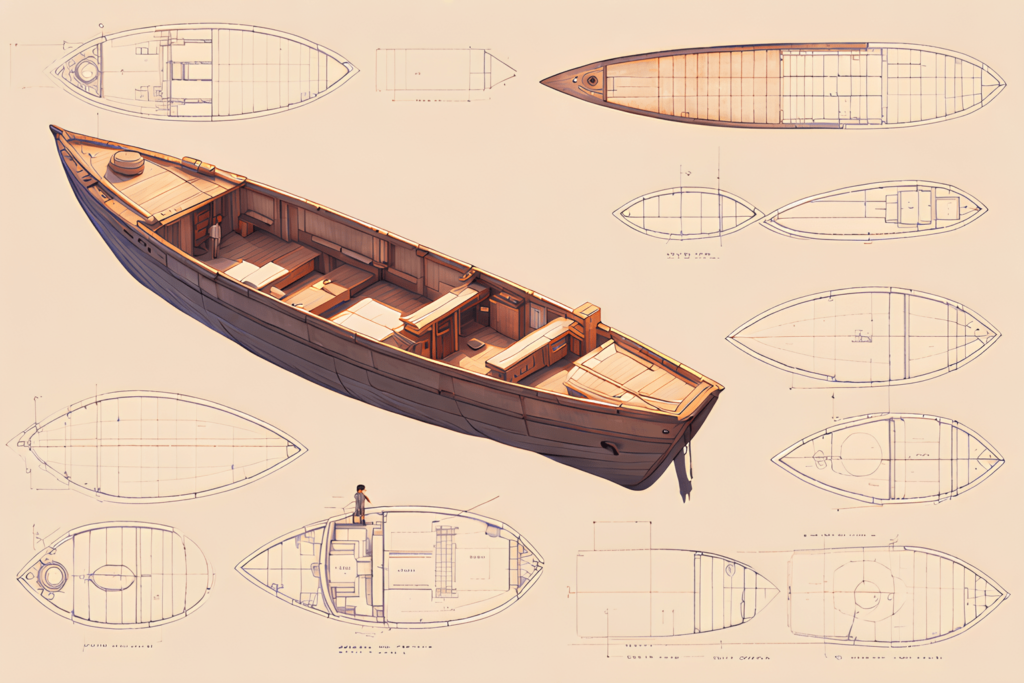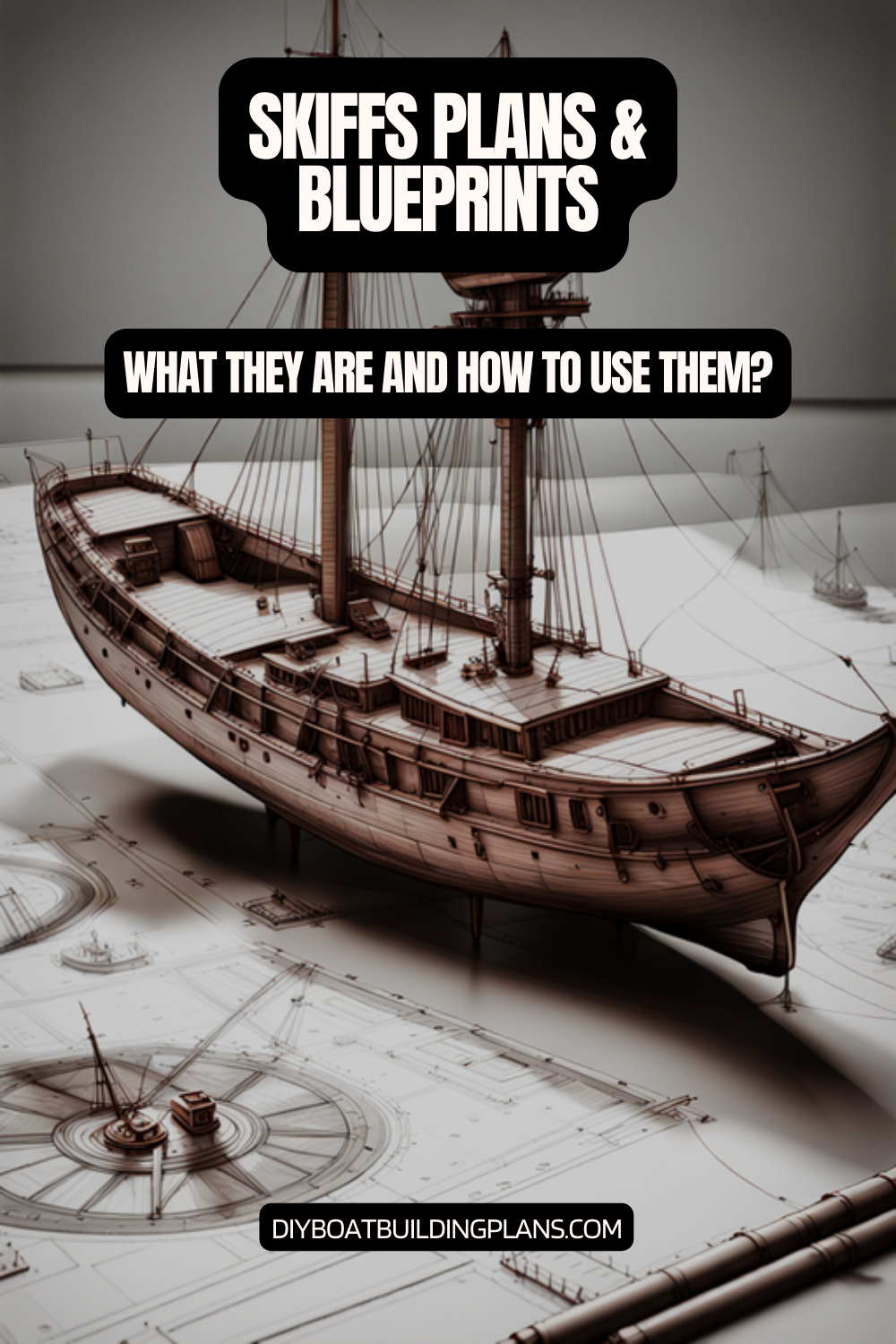Ever wondered how a weekend woodworker can turn marine-grade plywood into a beautiful watercraft? The world of DIY skiff plans and boat building guides is full of adventure and creativity. It lets you build your own watercraft.
Skiff construction manuals are a great chance to make a custom boat that fits your needs. Whether you love fishing or just enjoy exploring, these guides help you build a boat that’s all yours.
From the Flats River Skiff to the Jessy 12, there are many designs for builders of all levels. The right plan can make your dream of a boat come true. You’ll get full-size templates and step-by-step instructions.
Key Takeaways
- DIY skiff plans offer customizable boat-building experiences
- Basic carpentry skills can help you create a personal watercraft
- Multiple free and paid resources are available for boat builders
- Skiff designs range from fishing to recreational models
- Detailed blueprints make boat construction accessible to beginners

Understanding Skiffs: What Makes Them Unique?
Skiffs are a special group of small boats that are versatile, simple, and made with care. They have caught the eye of many who love boats and enjoy building their own. These DIY projects let people create their dream watercraft.
Definition of a Skiff
A skiff is a light, shallow boat made for rivers, estuaries, and coastal areas. They have a flat bottom and wide beam. This makes them great for moving through tight spaces.
- Typically have a shallow draft (as little as 6 inches deep)
- Designed for calm and protected water environments
- Highly adaptable for various water activities
Common Uses for Skiffs
Skiffs are good for many things, like fishing, boating for fun, and exploring. They are popular among those who love the water and want to try new things.
| Activity | Skiff Suitability |
|---|---|
| Fishing | Excellent shallow water access |
| Recreational Boating | Great for calm lakes and rivers |
| Exploration | Perfect for navigating tight waterways |
Advantages of Building Your Own Skiff
Making your own skiff is special. You get to choose everything, from design to materials. It’s a way to make a boat that fits your needs perfectly.
“Building your own skiff isn’t just about creating a boat—it’s about crafting an experience unique to your maritime dreams.”
- Full customization of design and features
- Cost-effective compared to purchasing pre-made vessels
- Personal satisfaction of creating your own watercraft
- Opportunity to learn advanced boat-building skills
Whether you love fishing or just enjoy the water, learning about skiffs opens up new possibilities. It’s a chance to follow your dreams with homemade boatbuilding and creative designs.
Selecting the Right DIY Skiff Plans
Choosing the perfect wooden skiff blueprints is key in your DIY boating projects. The right plans can make your boat-building journey fun and rewarding.
When looking at wooden skiff blueprints, several important factors will help you choose:
- Skill level and experience
- Intended boat usage
- Budget constraints
- Boat size and dimensions
Factors to Consider in DIY Boating Projects
Your skill level is a big factor in picking skiff plans. Beginners might start with simpler designs like the Slippery Dick 14 skiff, priced at $95. More experienced builders can try more complex projects like the Beryllium skiff, with lengths from 16′ to 18.9′.
Popular Sources for Skiff Plans
Many trusted sources offer detailed wooden skiff blueprints:
- Specialized boat design companies
- Online marine blueprint repositories
- Professional boat builder websites
- Maritime design forums
Free vs. Paid Plans
“Investing in quality plans saves time and prevents costly mistakes.”
Free plans are available, but paid blueprints usually offer more detailed instructions. For example, the Original Whipray skiff plans cost $300 and include detailed design sheets and interior options.
| Skiff Design | Price | Length | Speed |
|---|---|---|---|
| Conchfish 16 | $300 | 15’10” | 31 mph |
| Conchfish 17.5 | $350 | 17’5″ | 37-42 mph |
| Lithium 18′ | $350 | 18′ | 42 mph |
The right skiff plans should match your skills, budget, and boating dreams. Spend time researching and picking blueprints that excite your DIY boating projects.
Unlock the secrets to building your dream boat with MyBoatPlans! With detailed plans for over 518 boats and expert video tutorials, you’ll have everything you need to create your perfect vessel. Click here to begin your journey!
Materials Needed for Building a Skiff
Choosing the right materials is key to making a sturdy and dependable skiff. Whether you’re using aluminum skiff patterns or fiberglass skiff templates, knowing your options is important. It can greatly affect your boat-building project.
Essential Wood Types
Marine-grade wood is the foundation of most skiff builds. The top choices are:
- Marine Plywood (Okume or Meranti)
- Cypress
- Juniper
- Fir
Additional Materials and Tools
Building a skiff needs more than just wood. You’ll also need:
- Marine epoxy
- Fiberglass cloth
- Expanding pour foam
- Marine primer and paint
“The right materials can transform your skiff from a simple project to a masterpiece of craftsmanship.”
Sustainability Considerations in Material Choice
When picking materials for your skiff, think about the environment. Opt for sustainably sourced woods and eco-friendly epoxy resins. This helps reduce harm to the planet.
Pro tip: Always check the quality and marine-grade certification of your materials before starting your build.
Step-by-Step Guide to Building Your Skiff
Starting a small boat design project is thrilling for DIY fans. The stitch and glue method makes building a skiff easy and fun. It mixes simplicity with skill.
Preparing Your Workspace
Having the right workspace is key for building a skiff. You’ll need:
- A clean, well-ventilated area
- Minimum space of 15-20 feet long
- Sturdy work surface
- Essential tools and safety equipment
“The right workspace is half the battle in boat building” – Wooden Boat Magazine
Following the Blueprint
Being precise is important in small boat design. Your blueprint will show you the way:
- Trace full-size patterns onto marine-grade plywood
- Cut out individual pieces carefully
- Temporarily secure pieces with zip ties
- Check alignment and measurements
Key Construction Techniques
Stitch and glue boat building uses special techniques:
- Temporary stitching with wire or zip ties
- Applying thickened epoxy to create permanent joints
- Sealing wood with epoxy resin
- Reinforcing critical areas with fiberglass
With attention to detail and patience, you can turn raw materials into a beautiful skiff. It will show your craftsmanship and love for the sea.
Tips for First-Time Builders
Starting your first DIY skiff project is both thrilling and tough. With the right guides, beginners can make their dream boat. It’s all about being prepared, patient, and eager to learn.
Avoiding Common Mistakes
New builders often face similar issues. Here are key mistakes to avoid:
- Rushing through measurement and cutting stages
- Neglecting proper surface preparation
- Skipping essential safety checks
- Failing to read entire plans before starting
“Measure twice, cut once” is the golden rule in boat building.
Safety Precautions
Building a skiff needs careful safety focus. Protect yourself with:
- High-quality respiratory mask when working with epoxy
- Safety glasses and protective gloves
- Well-ventilated workspace
- First aid kit nearby
Support Groups and Resources
You’re not alone in your boat-building journey. Many resources can help first-time builders:
- Online forums dedicated to boat construction
- Local woodworking clubs
- YouTube tutorials on skiff building
- Workshops and community classes
Beginners should start with simpler designs like the Flats River Skiff 15. It helps build confidence. Remember, every expert was once a beginner, and each project is a learning experience in DIY skiff construction.
Customizing Your Skiff Design
Personalizing your skiff is an exciting part of the homemade boatbuilding instructions. It turns a standard vessel into a unique watercraft tailored to your specific needs. Skiff construction manuals offer many customization options. These allow builders to create a boat that reflects their individual style and meets their functional requirements.
When approaching custom design, consider these key aspects of personalization:
- Functional layout modifications
- Performance-enhancing features
- Aesthetic improvements
- Specialized fishing or recreational configurations
Popular Custom Features
Builders can enhance their skiffs with several innovative additions:
Download over 500 Boat Plans. Click on the link below.
-->Click Here<--
- Integrated trolling motor mounts
- Elevated casting platforms
- Custom storage compartments
- Specialized fishing accessories
Balancing Aesthetics and Functionality
The art of customization is about finding a balance. Choose modifications that not only look great but also improve your skiff’s overall utility.
How to Personalize Your Build
| Customization Area | Options | Considerations |
|---|---|---|
| Color Scheme | Custom paint, marine-grade finishes | UV resistance, durability |
| Seating | Adjustable, removable configurations | Comfort, versatility |
| Electronics | GPS, fish finders, communication systems | Mounting, power requirements |
“Your skiff should be as unique as your maritime adventures.” – Experienced Boat Builder
Remember, successful customization requires careful planning and understanding of your specific boating needs. Consult skiff construction manuals and seek advice from experienced builders. This ensures your modifications enhance your vessel’s performance without compromising it.
Maintaining Your Skiff
Keeping your DIY boat in top shape is key. Skiff owners who take care of their vessels can make them last longer. This ensures they have great sailing experiences.
Routine Maintenance Essentials
Looking after your small boat needs regular checks on a few important things:
- Inspect epoxy coating and fiberglass layers regularly
- Check for water ingress and possible structural weaknesses
- Clean the hull after each use
- Lubricate moving parts and hardware
Seasonal Preparation Strategies
Getting your skiff ready for different seasons is important:
- Apply fresh marine paint before storing
- Protect against UV damage
- Store in a covered, dry place
- Use custom cradles for your model
Repairing Common Issues
Fixing small problems is easy with the right steps:
| Issue | Repair Method | Materials Needed |
|---|---|---|
| Small Cracks | Epoxy Filling | Marine Epoxy, Fiberglass Cloth |
| Paint Chips | Sanding and Repainting | Marine Paint, Sandpaper |
| Loose Fittings | Tightening or Replacement | Appropriate Wrench, Marine Sealant |
“A well-maintained skiff is a sailor’s best companion on the water.”
Regular care turns your DIY boat into a trusted friend on the water.
The Cost of Building a Skiff
Building your own skiff is exciting and can save money. It’s great for water lovers. Knowing the costs is key to a successful project, whether you use wooden or aluminum plans.
Budgeting for Your Project
Plan your skiff budget well. The cost depends on several things:
- Materials: Marine-grade plywood and special woods
- Tools and equipment
- Epoxy and finishing materials
- Custom features and accessories
Hidden Costs to Anticipate
DIY skiff builders should watch out for hidden costs. Common surprises include:
- More specialized tools
- Replacement materials for errors
- Protective gear and safety equipment
- Design changes you didn’t plan for
DIY vs. Pre-Made Skiff Comparison
Here’s a cost comparison between building and buying a skiff:
| Aspect | DIY Skiff | Pre-Made Skiff |
|---|---|---|
| Initial Cost | $1,500 – $3,000 | $5,000 – $15,000 |
| Customization | High | Limited |
| Time Investment | 100-200 hours | None |
“The satisfaction of building your own skiff is priceless” – Experienced Boat Builder
Using wooden or aluminum plans can save a lot of money. With good planning and skills, you can avoid surprises and make a unique boat.
Real-Life DIY Skiff Success Stories
Exploring DIY skiff building reveals inspiring stories of boat builders. They turned their dreams into real boats. These tales show the creativity, determination, and skills needed to build unique small boats with fiberglass skiff templates.
Featured Builders and Their Projects
Skiff builders have made amazing boats with special features. Their projects show how versatile small boat design can be. They use different construction methods:
- Ultralight constructions focusing on portability
- Semi-heavy builds for increased durability
- Hybrid hull shapes for exceptional performance
Lessons Learned from Experienced Builders
Experienced skiff builders share important tips for success:
- Start with smaller projects to build confidence
- Carefully select materials like marine plywood
- Pay attention to precise frame and stringer alignments
“Each skiff build is a learning experience that transforms theoretical knowledge into practical craftsmanship.”
Inspiring DIY Skiff Ideas
Builders have tried new ways to build skiffs. They include:
| Hull Type | Key Characteristics | Best Used For |
|---|---|---|
| Flat Bottom | Stable, simple design | Calm waters, fishing |
| Vee Bottom | Improved speed, efficiency | Open water, longer distances |
| Hybrid Hull | Versatile performance | Multiple water conditions |
By being creative and persistent, DIY fans keep improving small boat design. They turn fiberglass skiff templates into unique boats.

Join the DIY Skiff Community
Building a skiff is more than just a solo project. It’s a chance to connect with woodworkers and boat lovers. The DIY skiff community offers great resources for building boats using the stitch and glue method. It helps both newbies and seasoned builders improve their skills.
Online forums are great places for DIY Skiff Plans & Blueprints fans to share and learn. Sites like WoodenBoat.com and Facebook boat building groups are virtual meeting spots. Here, builders share tips, showcase their work, and support each other through tough times.
Local workshops and classes offer hands-on learning that goes beyond online resources. Woodworking centers and maritime museums often host boat building sessions. Here, you can learn important skills like cutting, aligning the hull, and finishing with marine-grade materials under expert guidance.
Sharing your skiff building journey is a great way to connect with others. Use social media, forums, or local clubs to share your progress. Not only will you get feedback, but you’ll also inspire others to start their own boat building projects.
FAQ
How difficult is it to build a DIY skiff for a first-time boat builder?
If you know basic carpentry, you can start with the Flats River Skiff 15 or Jessy 12. These designs are easy to follow, with detailed plans and templates. Most beginners can build a skiff by following instructions and learning stitch and glue construction.
What materials do I need to build a typical skiff?
You’ll need marine-grade plywood, wood stocks, marine epoxy, fiberglass cloth, and expanding pour foam. For a Flats River Skiff 15, you’ll need 8 sheets of 1/4″ and 2 sheets of 3/8″ plywood. You’ll also need epoxy resin, fiberglass cloth, marine primer, and paint.
How much does it cost to build a DIY skiff?
The cost depends on the design’s size and complexity. A Flats River Skiff 15 might need 10 sheets of plywood, 200 linear feet of wood stocks, 6 gallons of marine epoxy, and 35 yards of fiberglass cloth. Building it yourself can save money, but remember to include material costs, tools, and your time.
What type of motor can I use with a DIY skiff?
The motor choice depends on the skiff’s design. For example, the Jessy 12 works well with a 9.9 hp motor, reaching speeds up to 20 mph. Motors from 4 hp to 8 hp have been used, with speeds ranging from 12-22 mph based on load and design.
Can I customize my DIY skiff?
Yes! DIY skiffs offer many customization options. You can add trolling motor mounts, casting platforms, power poles, and choose between bay boat or flats boat configurations. The FRS-18 is a flexible model that can be customized to fit your needs.
What building method is recommended for DIY skiff construction?
The stitch and glue method is recommended. It involves tracing patterns onto plywood, cutting pieces, and gluing them together with thickened epoxy. You’ll also seal the wood with epoxy resin and reinforce areas with fiberglass.
How do I maintain my DIY skiff after building?
Regular maintenance includes checking the epoxy coating and fiberglass layers, applying fresh marine paint, and looking for water ingress. Minor damage can be fixed with the same materials used in construction. Proper storage, like custom cradles, protects the boat when not in use.
Where can I find support and resources for building a DIY skiff?
You can find support online, in local workshops, and through guides. Online forums, workshops like the Wooden Boat Show Mystic Seaport, and guides like the Gougeon Brothers on Boat Construction offer advice and technical support.



